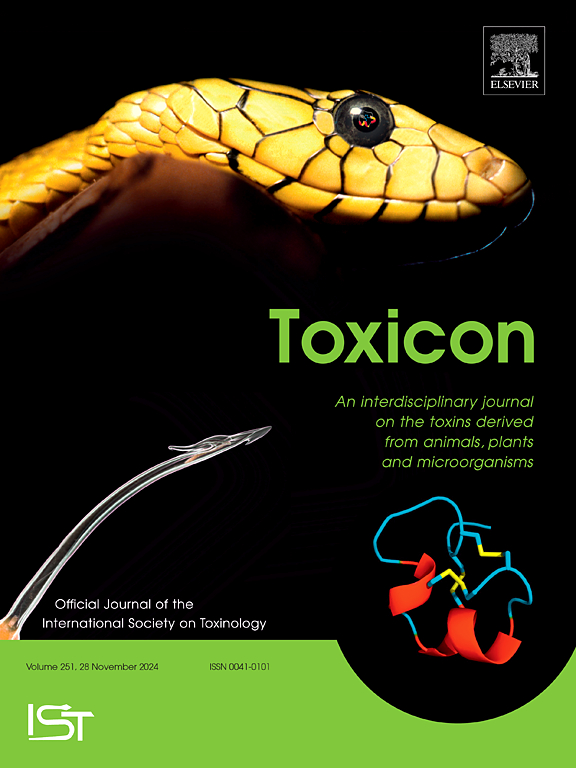发展实验室测试以评估抗蛇毒血清治疗蛇咬伤的中和效果的故事。
IF 2.6
4区 医学
Q2 PHARMACOLOGY & PHARMACY
引用次数: 0
摘要
自1894年以来,静脉注射动物源性抗蛇毒血清一直是治疗蛇咬伤的主要方法。蛇咬伤是一种被忽视的热带病,在全球范围内具有很高的发病率和死亡率。抗蛇毒血清开发和质量控制的一个关键考验是消除毒液的致死作用。自早期抗蛇毒血清以来,对蛇毒致命性的中和主要是基于在实验室动物注射前对蛇毒和抗蛇毒血清进行孵育。目前的叙述回顾总结了主要里程碑的发展毒液中和测定抗蛇毒血清,开始与Calmette和Vital巴西的先驱工作。尽管20世纪采取了各种措施来标准化这些测试,但抗蛇毒血清功效分析在实验室和国家之间存在高度差异。讨论了为了解决定致死率试验的主要变量所作的努力,同时介绍了评估毒液的其他相关毒性和酶活性的中和作用的测定方法,这些方法补充了致死率试验。在过去几十年中,由世界卫生组织(世卫组织)协调的国际努力导致世卫组织发布了《抗蛇毒血清生产和控制准则》,其中详细说明了临床前中和试验,包括基本试验,即致命性试验,以及评估其他相关毒性效应的补充试验。传统抗蛇毒血清中和试验中动物的痛苦和折磨,迫切需要在抗蛇毒血清功效评估中实施3Rs原则(替代、还原、细化),迫切需要在该领域进行创新。本文章由计算机程序翻译,如有差异,请以英文原文为准。

The saga of the development of laboratory tests to evaluate the neutralizing efficacy of antivenoms for the treatment of snakebite envenoming
The parenteral administration of animal-derived antivenoms has been, since 1894, the mainstay of the therapy of snakebite envenoming, a neglected tropical disease that exerts a high toll of morbidity and mortality on a global basis. A key test in the development and quality control of antivenoms has been the neutralization of the lethal effect of venoms. Since the early times of antivenoms, the neutralization of venom's lethality has been predominantly based on the incubation of venom and antivenom prior to the injection in laboratory animals. The present narrative review summarizes the main milestones in the development of venom neutralization assays by antivenoms, starting with the pioneer work of Albert Calmette and Vital Brazil. Despite various initiatives along the 20th century to standardize these tests, the antivenom efficacy assays have been highly heterogeneous between laboratories and countries. Efforts carried out to understand the main variables that determine the lethality neutralization tests are discussed, together with the introduction of assays to assess the neutralization of other relevant toxic and enzymatic activities of venoms, which complement the lethality assay. In the last decades, international efforts coordinated by the World Health Organization (WHO) led to the publication of the WHO guidelines for the production and control of antivenoms, which comprise detailed descriptions of preclinical neutralization assays, including the essential test, i.e., lethality, and supplementary assays that assess other relevant toxic effects. The pain and suffering of animals in the traditional antivenom neutralization tests urge the implementation of the 3Rs principles (replacement, reduction, refinement) in antivenom efficacy assessment, and innovation is urgently needed in this field.
求助全文
通过发布文献求助,成功后即可免费获取论文全文。
去求助
来源期刊

Toxicon
医学-毒理学
CiteScore
4.80
自引率
10.70%
发文量
358
审稿时长
68 days
期刊介绍:
Toxicon has an open access mirror Toxicon: X, sharing the same aims and scope, editorial team, submission system and rigorous peer review. An introductory offer Toxicon: X - full waiver of the Open Access fee.
Toxicon''s "aims and scope" are to publish:
-articles containing the results of original research on problems related to toxins derived from animals, plants and microorganisms
-papers on novel findings related to the chemical, pharmacological, toxicological, and immunological properties of natural toxins
-molecular biological studies of toxins and other genes from poisonous and venomous organisms that advance understanding of the role or function of toxins
-clinical observations on poisoning and envenoming where a new therapeutic principle has been proposed or a decidedly superior clinical result has been obtained.
-material on the use of toxins as tools in studying biological processes and material on subjects related to venom and antivenom problems.
-articles on the translational application of toxins, for example as drugs and insecticides
-epidemiological studies on envenoming or poisoning, so long as they highlight a previously unrecognised medical problem or provide insight into the prevention or medical treatment of envenoming or poisoning. Retrospective surveys of hospital records, especially those lacking species identification, will not be considered for publication. Properly designed prospective community-based surveys are strongly encouraged.
-articles describing well-known activities of venoms, such as antibacterial, anticancer, and analgesic activities of arachnid venoms, without any attempt to define the mechanism of action or purify the active component, will not be considered for publication in Toxicon.
-review articles on problems related to toxinology.
To encourage the exchange of ideas, sections of the journal may be devoted to Short Communications, Letters to the Editor and activities of the affiliated societies.
 求助内容:
求助内容: 应助结果提醒方式:
应助结果提醒方式:


